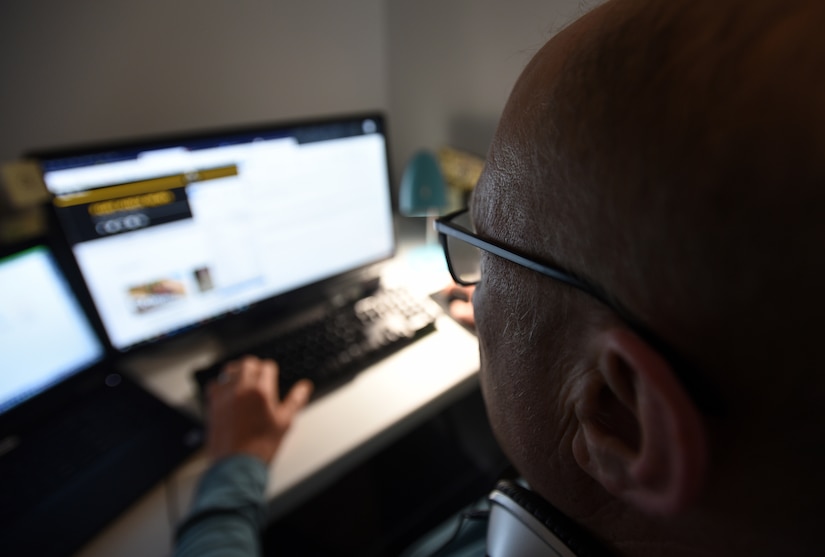April 13, 2020 | BY C. Todd Lopez , DOD News
To keep business on track during the fight against
coronavirus, the Defense Department has greatly expanded its telework
capability with a variety of tools. Once the coronavirus threat has receded,
some of those enhancements for telework may continue on in some capacity, DOD's
chief information officer said.
"We are creating a much more robust enhanced
teleworking capability, [and] we've obviously always had one. What we've now
done is we've just put a multiplier effect into the quantity, the types of
services, the collaboration tools, etc.," Dana Deasy told reporters today
at a Pentagon news conference. "So there will be some permanency to what
we have here. ... There is going to be an enhanced teleworking capability that
will be sustained at the end of COVID-19."
The telework capability that might outlive the pandemic will
be related to enhanced network capability, and will also include a larger base
of teleworking equipment, Deasy said, but it's not just limited to technology.
"We've also just developed some new tactics and
techniques that allow us to ramp up quite quickly," he said, adding that
the department had "significant help" from industry partners to
support the large numbers of Defense Department employees who are working
offsite due to social distancing and stay-at-home orders.
Air Force Lt. Gen. B.J. Shwedo, the Joint Staff's director
for command, control, communications, and computers/cyber and chief information
officer, said as many as 4 million DOD military and civilian workers are now
teleworking.
The Army, he said, has about 800,000 telework-enabled
members on Defense Department networks, and the demand is increasing daily. The
Navy, he said, had 100,000 remote workers on its networks before the
coronavirus pandemic, and that has more than doubled to 250,000 workers.
"Planned improvements in the next two to three weeks will bring the total
to 500,000 remote users," Shwedo said.
The Navy's use of Outlook Web Access, he said, was at about
10,000 users before the pandemic, and usage may climb to some 300,000 users by
the end of the month. The Marine Corps, he said, expects its OWA users to
increase from about 70,000 to more than 105,000.
The Air Force, he added, has increased virtual private
network capability from 10,000 to more 100,000 today, with an expectation to go
to 200,000 in coming weeks. "They're now using a tool that is going to
bring this capability to over 400,000 users," Shwedo said.
The many telework-enabling tools now available to Department
employees are explained at http://public.cyber.mil, Deasy said. One of those,
he said, is the "commercial virtual remote" environment that provides
collaboration capabilities including video, voice and text.
"CVR was created to support the department during the
current large-scale teleworking environment due to the COVID-19 national
emergency," he said. "The tool is just one of several tools available
to the workforce and provides remote workers with enhanced collaboration capabilities."
The rollout for CVR began March 27, and it already has more
than 900,000 activated user accounts, Deasy said.
"At one point last week, we added over 250,000 accounts
in a single day," he said. "This is the largest rollout ever
implemented in this short amount of time."
The recently stood-up COVID-19 Telework Readiness Task Force
has spearheaded much of the effort to get employees online from home to keep
doing their jobs, Deasy said. The task force, he said, focuses on areas such as
equipment needs, network capacity, operational readiness, information
technology personnel, contracting readiness, supply chain, finance requirements
and cybersecurity.
"We meet daily for about two hours to review and
address various technical issues and requests as they arise," he said.
Deasy also said efforts during the coronavirus pandemic are
not just related to getting employees online for telework. DOD also is helping
on the front lines of the coronavirus fight as well.
In New Orleans, he said, the department provided two field
hospitals with a one-gigabyte internet connection, [internet protocol] phones,
connectivity between locations and switches to connect it all together.
"A request such as this generally requires months of
planning, procuring equipment, and, of course, hiring the teams to
install," he said. "Due to our strong partnership with industry, the
job was completed in just one day."
One effect of increased telework and the coronavirus
pandemic has been an increase in "spear phishing" — attempts by
malicious actors to compromise target computers.
"I'll tell you that [with] the insight that we're
receiving, we're getting better and better at getting their [tactics,
techniques and procedures] and finding out where these threat vectors are
coming from," Shwedo said.







No comments:
Post a Comment